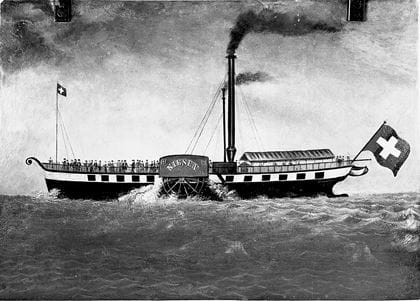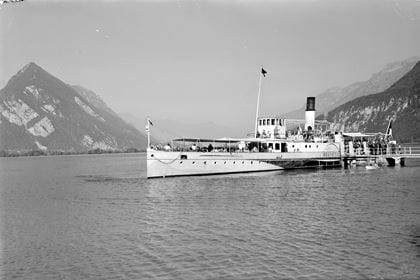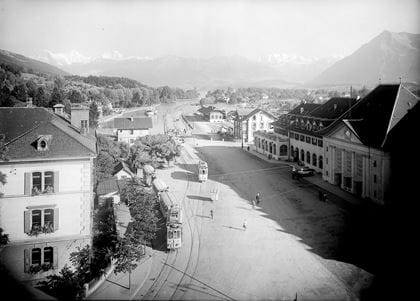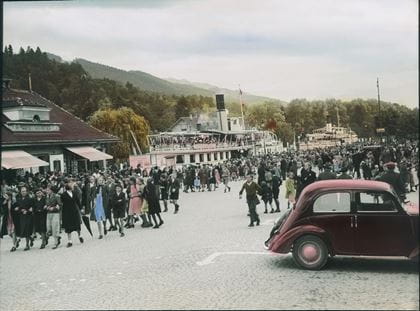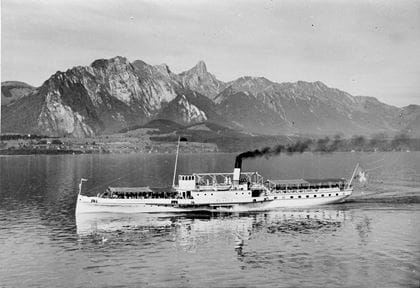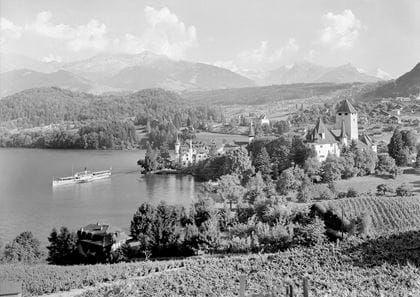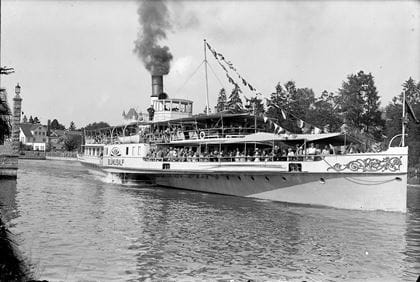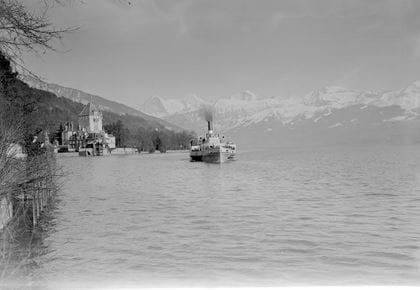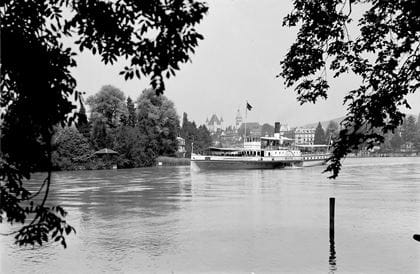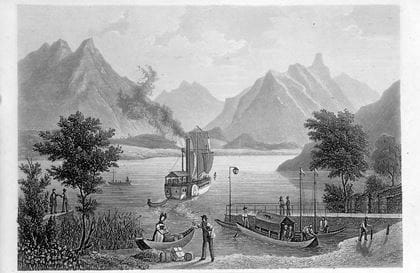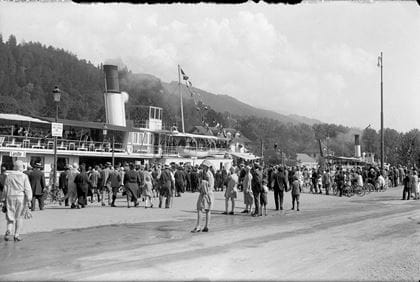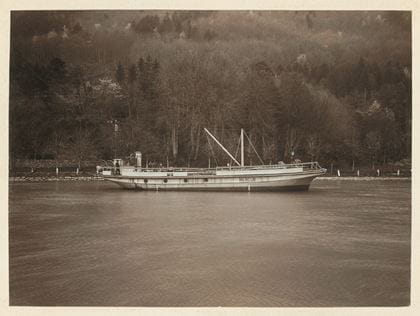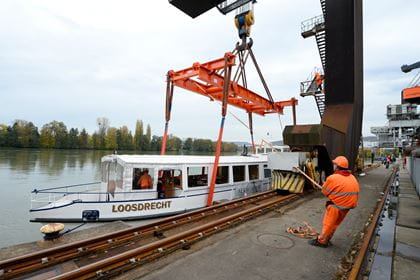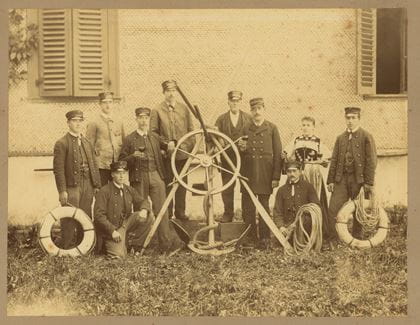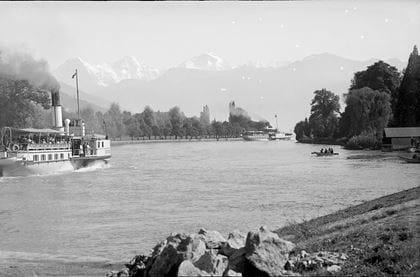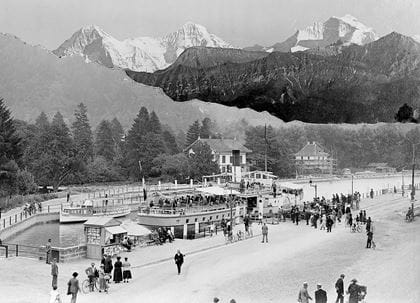Age verification
The history of BLS Navigation
Over 180 years ago, brave pioneers revolutionised the waterways of the Bernese Oberland. Navigation services on Lakes Thun and Brienz connected the local population with the rest of the world and laid the foundation stone for modern tourism in the Bernese Oberland.
The history of navigation services in the Bernese Oberland
The Knechtenhofer brothers – innovative hoteliers
In 1834, the Knechtenhofer brothers laid the foundation stone for boat excursions on Lake Thun. In order to liven things up for their hotel in Thun, they ordered a 16 horse-power iron steamboat from the Cavé engineering works in Paris. By the summer of 1835, the "Bellevue" was already operating on the Hofstetten to Neuhaus route, a trip that took around 75 minutes without any stops.
The success of this new means of transport gave hotelier David G. Matti from Kienholz the idea of bringing a small steam-powered vessel from Lake Geneva to Lake Brienz, which involved following some risky paths. From 1839, the renamed "Giessbach" started sailing between Interlaken and Brienz with a stop in Giessbach.
Lots of toing and froing on the lakes of the Bernese Oberland
On the lower lake, the Knechtenhofer brothers were struggling against a second steamboad company. They joined forces with the competition and founded the "Vereinigte Dampfschifffahrts-Gesellschaft für den Thuner- und Brienzersee" – usually abbreviated to the "VDG".
Then in the winter of 1842/43, the «Bellevue» was transported to Lake Brienz, where it operated until 1857 renamed the «Faulhorn». Hotelier Matti reacted with a switch: from 1843, the "Giessbach" operated between Hofstetten and Neuhaus and was therefore in competition with the new VDG vessel, the «Niesen». In 1846, the VDG purchased the boat from Matti and renamed it the «Helvetia».
By 1856 another competitor had popped up on Lake Brienz: the then owners of the Hotel Giessbach started up boat trips to Interlaken and Brienz with their own screw steamer, the "Giessbach". In 1857, the hotel, along with its boat, passed into the ownership of the VDG. Shortly afterwards, the "Giessbach" was decommissioned – supposedly due to a design fault. In 1870, the VDG sold on the Giessbach hotel and boat.
New boats, new railways
During this time, more steamboats were put into service on Lakes Thun and Brienz: "Stadt Thun" (1856), "Interlaken" (1857), "Giessbach" (1859) and "Stadt Bern" (1861). The "Faulhorn" was converted into a barge and put back on Lake Thun where it sank in a storm off Oberhofen in 1864.
In the meantime, traffic on Lake Thun increased greatly and freight transport had to be moved from the passenger ships onto barges. With this in mind, in 1861 the steamboat company acquired the Aare steamer the "Neptun", which was in service until 1873.
Dissatisfied interested parties from the Interlaken area founded the Oberländische Dampfschifffahrts-Gesellschaft in 1869 with the VDG service on Lake Brienz. However, it was liquidated before it could go into service. As a result, the saloon steamer that had been ordered operated for the VDG on the lake from 1870 as the "Oberland".
During this period, a few more steamers were launched: the "Beatus" (1871), "Brienz" (1871) and "Bubenberg" (1874). The timing of the expansion of the fleet proved to be favourable, because after the Franco-Prussian War of 1870-71, traffic on Lakes Thun and Brienz increased noticeably.
In 1874, the Bödeli Railway was opened. This resulted in the upper terminus of the Lake Thun ships being moved from Neuhaus to Därligen and operations from Interlaken to Bönigen discontinued. As early as 1873, Bödeli Rail put its own ferry into service on the Scherzligen–Därligen route which was capable of transporting four to five goods wagons. Another train ferry with the capacity for five to six goods wagons was in use from 1886.
The opening of more railways within a space of just a few years had a positive effect on the development of navigation services: the Brünig Railway (1888), the Lake Thun-Beatenberg Railway (1889), Bernese Oberland Railways (1890) and the Brienz-Rothorn Railway (1892). As Bernese-Oberland Railways was also linked to the Bödeli Railway at Zollhaus station (Interlaken East today) and the company was building a new station there, the shipping route from Bönigen to Interlaken was opened up again from 1891.
Under a new flag
In 1889, the Lake Thun fleet was expanded with the addition of a new steamer called the "Helvetia" in order to be able to meet the increasing demand. In view of the completion of the railway between Scherzligen and Därligen, the VDG had the 2.75 km long ship canal from Lake Thun to Interlaken West station built between 1890 and 1892, and this still operates today.
After opening the Lake Thun Railway in 1893, the boat service initially had to accept considerable financial losses which were fortunately compensated for by an increase in tourism. However, the time of the ferry service was well and truly over.
Taken into service on Lake Thun were the tugboat "Neptune" (1901), the screw steamer "Spiez" intended for local passenger transport (1901) and the handsome saloon steamer "Blümlisalp" (1906). Meanwhile on Lake Brienz the steamboat "Jungfrau" (1898) and motor cargo vessel "Mercur" (1901) were put into operation.
After tough negotiations in 1912, the VDG and Lake Thun Railway merged, only to be taken over in 1913 by the Bernese Alpine railway company, Bern-Lötschberg-Simplon (BLS). BLS has been responsible for navigation services on both lakes of the Bernese Oberland ever since.
The breakup
Shortly before the First World War, navigation services on both lakes experienced a temporary highpoint: in 1914 the new saloon steamer "Lötschberg" was put into service. However, after only nine days it was taken out of service because of the breakout of war.
The era of proud saloon steamers was over – the easy-going belle époque was overtaken by reality. Shipping came almost completely to a standstill and was occasionally stopped entirely in the winter of 1917/18 due to a lack of coal.
During this period, there also came the opening of the Lake Thun Railway on the right bank (1914) and the Brünig Railway was extended from Brienz to Interlaken (1916). These two rail lines made navigation services for the most part redundant for non-scheduled services.
Because of the coal shortage and to rationalise operational management, the motor cargo vessel "Mercur" was replaced in 1918 by the motor vessel "Mars" which had been active on Lake Lucerne. From then on, it sailed Lake Brienz as the "Iseltwald".
In 1920, BLS purchased the MS "Astra" from the Lake Lucerne Steamboat Company which was put into operation on Lake Thun as the MS "Gunten".
The Second World War
With the amalgamation of the old Thun and Scherzligen stations to become the new central Thun railway station, in 1923 the question of linking the railway with navigation services on Lake Thun was discussed. The ideal solution came about in 1925 with the construction of the ship canal to the new rail station.
At the end of the 1920s, passenger traffic increased again and primarily on Lake Thun. But the economic crisis of the 1930s hit navigation services hard again. In the wake of rationalisation, there followed the acquisition of the motor vessels "Morgarten" (in 1928, in service from 1949 as the "Harder") and the "Niesen" (1935). This meant the end of the line for the steamboats "Stadt Thun" (1929) and "Oberland" (1932).
In 1936, the Swiss franc fell in value by 30 per cent, which resulted in a renewed increase in tourism in the Bernese Oberland. Therefore, two new motor vessels were launched in 1940: the "Thun" and the "Oberhofen", which had been used in 1939 for the Swiss National Exhibition in Zurich. Scarcely had tourism recovered when the Second World War broke out.
The post-war years
The end of the Second World War marked the beginning of a new golden age of tourism. Many vessels had become outdated in the meantime and were no longer cost-effective, so replacement of the Lake Thun fleet was on the horizon.
On Lake Brienz on the other hand, after many years of deficit, the question of a complete halt to operations arose. However, as the surrounding regions are dependent on income from tourism, BLS decided to also rejuvenate the fleet here. So in 1950 the MS "Rothorn" and in 1956 the MS "Interlaken" were both launched. The last two newcomers to Lake Brienz are the motor vessels "Iseltwald" (1969) and "Brienz" (1981).
In a spectacular feat of transportation in 1999, the Lake Thun vessel "Jungfrau" was moved over to Lake Brienz and provided with a new, ornate coat of paint. The smaller MS "Harder" was sold in the middle of 2001. It has been working since then as the "Schwan" on Lake Zug.
A series of further motor vessels followed on Lake Thun: the "Jungfrau" (1954), "Stadt Bern" (1956), "Niederhorn" (1959), "Bubenberg" (1962) and "Beatus" (1963). In 1971, the saloon steamer "Blümlisalp" was withdrawn from service, only to be replaced by a motor vessel bearing the same name. After recommissioning of the old "Blümlisalp", it was renamed the "Stadt Thun" in 1992. The fleet was further expanded with the MS "Stockhorn" in 1974 and the MS "Berner Oberland" in 1996.
More of an experience whatever the weather
In the year 2000, BLS tried to achieve increased passenger numbers even in poor weather thanks to "themed boats": in the winter of 2000/2001, thanks to an idea from Thun artist Heinz von Gunten, the "Stadt Thun" was converted into a dragon ship. This one-of-a-kind vessel attracted great attention, even beyond Switzerland's borders.
It was also possible to simultaneously establish the "Fabulous Lake Thun adventure region", in which a series of products and services were offered bearing a dragon logo. In the winter of 2003/2004, the dragon ship was turned back into the "Stadt Thun".
But even traditional boat trips were not short-changed in the meantime: in the 2000/2001 winter, the Lake Brienz steamer the "Lötschberg" was renovated according to specifications from the Swiss Office for the Preservation of Historical Monuments. The new seminar and event vessel, the MS "Schilthorn" with its modern technical infrastructure, has also been operating on Lake Thun since June 2002.
Tradition and innovation
In 2006, the steamboat "Blümlisalp" celebrated its 100th birthday. In the winter before this, the "old lady" was cleaned up ready for the celebrations with a major renovation project.
In 2008 and in keeping with the times, the MS "Stockhorn" was converted into the first lounge boat in Switzerland. In the same year, the International Council on Monuments and Sites (ICOMOS) honoured the restoration of the saloon steamer "Lötschberg" with the "2008 Special Award".
In 2009, Bernese Oberland Navigation reported record utilisation of its scheduled service boats.
History of navigation services in the Bernese Oberland from 1834 to today
1834
Maiden voyage of the "Bellevue", the first steamboat on Lake Thun with capacity for 200 people on 31 July 1835
1839
Maiden voyage of the small steamboat "Giessbach" on Lake Brienz on 15 May 1839
1842
• Founding of the Vereinigte Dampfschifffahrtsgesellschaft Thuner- und Brienzersee (VDG) on 8 November 1842
• Transfer of the SS "Bellevue" to Lake Brienz, now operating under the name of the "Faulhorn"
1843
• Transfer of the steamboat "Giessbach" to Lake Thun with a new name: "Matti-Schiff"
• Maiden voyage of the new paddle steamer "Niesen" on Lake Thun - 28 June 1843
1846
The VDG purchases the "Matti-Schiff" and now operates it under the name "Helvetia"
1856
Putting into service of thesteamboat "Stadt Thun" on Lake Thun
1861
Putting into service of the steamboat "Stadt Bern" on Lake Thun
1857
Putting into service of the steamboat "Interlaken" on Lake Brienz
1859
Putting into service of the steamboat "Giessbach" on Lake Brienz
1861
Acquisition of the tugboat "Neptun" for handling freight transport
1864
Movement of the steamboat "Faulhorn" (previously the "Bellevue") back to Lake Thun, where it sank during a storm after subsequently being converted into a barge
1869
• Founding of the "Oberländische Dampfschifffahrtsgesellschaft" on Lake Brienz
• Saloon steamer the "Oberland" is ordered by the "Oberländische Dampfschifffahrtsgesellschaft"
1870
Takeover of the "Oberländische Dampfschifffahrtsgesellschaft" by the VDG
1871
Purchase of the steamboat "Beatus" and "Brienz"
1873
Putting into service of the first ferry on the Scherzligen–Därligen route
1874
Purchase of the steamboat "Bubenberg"
1889
Acquisition of the new steamer "Helvetia" on Lake Thun
1892
Construction of the ship canal to Interlaken West
1898
Putting into service of the steamboat "Jungfrau" on Lake Brienz
1901
• Putting into service of the screw steamer "Spiez" and tugboat "Neptun" on Lake Thun
• Putting into service of the motor cargo vessel "Mercur" on Lake Brienz
1906
Maiden voyage and naming of the handsome saloon steamer "Blümlisalp" on 31 July 1906
1913
Takeover of the VDG by the Bernese Alpine railway company Bern-Lötschberg-Simplon (BLS)
1914
Putting into service of the saloon steamer "Lötschberg", which was then taken out of service after just 9 days of operation, because of the outbreak of the First World War
1918
The motor cargo vessel "Mercur" is replaced by the motor vessel "Mars" and from that point sails on Lake Brienz under the name of "Iseltwald"
1920
Acquisition of the motor vessel "Astra", which is put into service on Lake Thun as the MS "Gunten"
1925
Construction of Thun ship canal from Scherzligen to the new railway station
1928
• Purchase of motor vessel "Morgarten" which worked on Lake Brienz from 1949 as the "Harder"
• Purchase of motor vessel "Niesen" for Lake Thun
1929
Decommissioning of steamboat "Stadt Thun" (Lake Thun)
1932
Decommissioning of steamboat "Oberland" (Lake Brienz)
1940
Putting into service of motor vessels "Thun" and "Oberhofen"
1950
Putting into service of motor vessel "Rothorn" on Lake Brienz
1956
Putting into service of motor vessel "Interlaken" on Lake Brienz
1969
Putting into service of motor vessel "Iseltwald" on Lake Brienz
1981
Putting into service of motor vessel "Brienz" on Lake Brienz
1996
Putting into service of motor vessel "Berner Oberland"
1999
Spectacular transportation of redesigned motor vessel "Jungfrau" from Lake Thun to Lake Brienz
2001
For three summer seasons, the motor vessel "Stadt Thun" sails on Lake Thun in the guise of the "Dragon Ship Fauchi"
2002
Putting into service of the business motor vessel "Schilthorn"
2006
The renovated steamboat "Blümlisalp" celebrates its 100th birthday
2008
Renovation and remodelling of motor vessel "Stockhorn" to become the first lounge boat in Switzerland
2009
Record utilisation of scheduled service boats on Lakes Thun and Brienz
2010
Navigation services on Lake Thun celebrate their 175th anniversary
2013
Repurchase and transportation to Lake Thun of the motor vessel "Oberhofen", which had been in service in the Netherlands as the "Vriendschap"
- 1'411 KB Jubiläumszeitung «175 Jahre Schifffahrt auf dem Thunersee» 1835 - 2010

